

Use of a class web site in the Science Classroom
Overview
While I was an undergraduate student I undertook a project to design a teacher web site suitable for student and teacher use. At first it was simply a collection of links to other web sites that could help students with the material in the science courses they were studying. From there it grew piece by piece to into its current form.
|
There have been three generations of the web site I currently use in class. The first generation was simply a text based site and was not very appealing nor useful. The second generation site became a more graphically oriented site that utilized frames to help people navigate the site. The overall appeal and usability of the page was very limited and the black space provided good contrast but it created a lot of dead space. This should be improved in future versions. The gradebook was a problem since it was basically an Excel spreadsheet where students could see every one else's grade. They spent more time comparing their grade to others rather than evaluating their grade to see if it meets their expectations and level of work. The next generation gradebook should have a password protected grade sheet for each student. It was hosted on the school district web server which was very slow and developed many problems throughout the course of the year. It was decided that the site would be relaunched with a new design on a commerical server so that it could have a discrete name rather than being housed in a directory of the district server. The new web site address was to be www.MrFlint.com where it can be located to this day. |
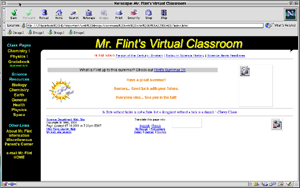 |
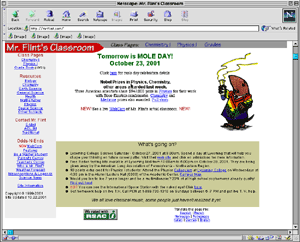 The third generation site is not text nor frames based but is of a very intuitive graphical design that is easy to navigate, quick loading, and more feature-rich. The design of the page is very common to the best commercial web sites. This site launched January 2001.
The third generation site is not text nor frames based but is of a very intuitive graphical design that is easy to navigate, quick loading, and more feature-rich. The design of the page is very common to the best commercial web sites. This site launched January 2001.
Some features of the current web site include:
Feel free to visit the site at www.MrFlint.com to see all it has to offer.
Method
I wish to study the impact of a class web site on students' attitudes about science courses.
Since this web site has been in use since the beginning of the course in its current form I cannot directly measure the students' change in attitude as the site is introduced. Rather I will use students' experience with other courses that don't use a web site to aid instruction. Since very few teachers use a web site to accompany their course it will be easy to measure the quality and rate of use of the web site.
A survey will be given to the students which will poll them in the following areas:
Additionally the number of times the web site is visited will be polled using a web counter. This counter can track the number of hits by IP (Internet Protocol address) which will show the total number of computers used to access the site. It will also count the total number of discrete hits to determine the total number of visits. A discrete hit is a hit to the home (index) page of the site from a separate IP. Subsequent hits from the same IP only register when made outside a 30 minute period. From this data the average number of hits per IP and discrete hits will be calculated on a weekly basis
Results
The results of the presurvey show that students have ready access to computers and the internet. Their use of the internet is diverse while their knowledge of computers and the internet is gleaned mainly from independent learning rather than from formal computer courses.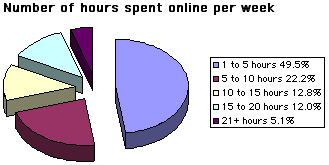 |
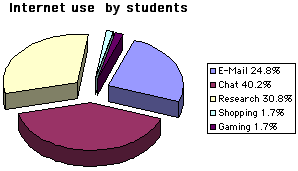 |
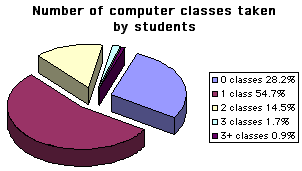 |
These data indicate that computer use among students is widespread and varied. The proliferation of intenet connections shows a dramatic increase in the number of connected households. Although a this survey has only been conducted once, an informal survey of home internet connection is conducted annually. A very noticable increase in the number of home internet connections has been noticed in the past year. One year prior to this survey approximately 80% of students had a home internet connection; two years ago it was about 75% and three years ago it was about 70%. This increase can be attributed to lower computer cost, lower internet connection cost, greater availability of internet connections, and increased societal requirements for families to be online.
Students find many uses for computers and are often at the cutting edge of the technology. Many report using computers for a variety of purposes ranging from academc to entertainment to commercial uses. They recognize that internet capable computers are not restricted to single uses but rather have a variety of potential applications.
The use of e-mail and instant messaging applications has changed the way students communicate with each other and the teacher. Not only does computer-enabled communication provide another mode of information exchange, it also allows new types of data to be shared. Rather large data files can be transferred from one computer to a remote location rather quickly. This permits science students to share laboratory data and results with relative ease without having to meet in person.
The face of commuication has shifted as well. Students can hide behind the relative anonymity of electronic mail and instant messaging to share their thoughts more freely. The amount of shyness and inhibition related to the inititation of conversation can be drastically reduced by sending an electronic message rather than a having person to person interaction. Interpersonal communication takes on new dimensions with these communication modes.
The culture of the school more readily continues outside of the school walls with the use of the Internet. Students usually only communicated with each other while at school before the birth of the Internet. Now they regularly engage in conversations on e-mail
The following table is a summary of the weekly hit hit count for the first marking period (August 28 - November 2, 2001).
| Hits | |
| Total independent IP hits | 218 |
| Total discrete hits | 2956 |
| Average discrete hits per week | 329.4 |
This indicates that many students and their parents reguarly visit the web site
Reflection
There have been many benefits from operating the classroom web site. A great deal of classroom distractions and interruptions can be reduced or eliminated by using the web site.Students can access a detailed record of their grades at all times which greatly reduces the amount of time required to update students as to their grades on a periodic basis. At the end of the marking period students can access their grades before they see their report cards so that there are no surprises. By referring students to the web site to see their grade there is an overall reduced workload for the teacher. The program used to compute grades automatically creates the web sites so there is little front end time investment. This time is easily made up in the current system.
The web site greatly reduces the ability for students to make excuses for not having their assignments complete. Since nearly all students have access to the web at home they can see what assignments are due between two and seven days in advance. Copies of worksheets and laboratory exercises are also available online.
The communication connection afforded by e-mail and instant messenger allows quick and efficient communication between the teacher and students and parents. During the first marking period 45 e-mails from 30 different students and 9 different parents were received regarding classroom policies, homework help, and scheduling questions.
Students seem to respect the fact that their teacher is capable of creating a fairly decent web site. They recognize that teachers have many interests and abilities outside the curriculm area in which they teach. This shows that they understand that many teachers are very multidimensional.